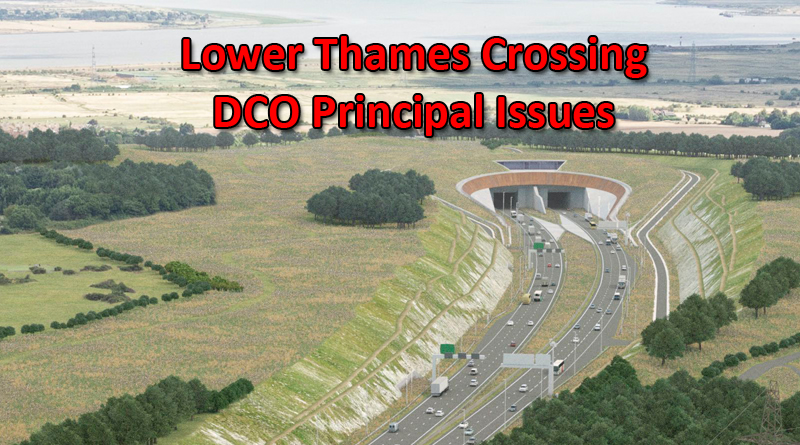LTC Principal Issues
The Planning Inspectorate have published their initial assessment of Principal Issues with the LTC. These were published within Annex B of the Rule 6 Letter.
The Principal Issues have been identified from the application documents, additional submissions that it has requested and accepted, including the summaries of Principal Areas of Disagreement (PADs), and all valid Relevant Representations received in respect of
the application. It is not a comprehensive or exclusive list of all relevant matters, and it also represents a snapshot in time.
New issues may arise. Some of the issues identified here may increase in relevance and weight during the Examination and some may decrease or cease to be principal issues. The ExA will have regard to all important and relevant matters during the Examination and when it writes its Recommendation Report to the Secretary of State for Transport (SoSfT) after the Examination has concluded.
Principal Issues
There are a number of matters that will be taken into account as overarching or internal components of the issues listed here:
- the achievement of good design
- the achievement of sustainable development
- the effects of the proposed development
- the effects of linkages between issues – and by way of example these include but are not limited to:
- links between tunnelling, the management of waste materials, aquifer and groundwater, construction traffic, the natural environment, agriculture, landscapes, visual impacts and mitigations of those effects
- links between daylight, overshadowing, light emissions and matters such as residential amenity and natural environment effects
- links between the effects of the proposed development and other major projects and proposals (cumulative and in-combination effects)
- the effects of the proposal in relation to human rights and equalities duties
All listed issues will be considered as necessary in terms of their effects over time; their construction and operational dimensions, including as necessary questions of:
- data, assessment and design methodology
- construction effects
- operational effects
- mitigation proposals and their effects
All listed issues will also be considered as necessary in terms of their spatial effects, which may differ depending on their location (recorded here from south to north):
- in wider Kent (including the proposed A2/ M2 works and wider land requirements)
- in the Kent tunnel approach (the environs of Shorne, Thong, Riverview Park and Chalk)
- in the tunnel portals and alignments (beneath the River Thames and foreshores in Kent and Essex)
- in the River Thames, affecting the environmental values and uses of the river
- in the Essex tunnel approach (the environs of Coalhouse, East and West Tilbury, Linford, Chadwell St Mary and Orsett Heath)
- in the environs of the proposed A13/A1089 intersection (Baker Street and Orsett) and linkages to the Essex ports
- in the environs of the Mardyke Valley (including Stifford)
- in the environs of the proposed M25 intersection (South Ockenden and North Ockenden)
- in wider Essex (including the proposed M25 works and wider land requirements)
1. Project definition
- Is the proposed development one nationally significant infrastructure project (NSIP) or more than one?
- The scope of and security for highway development
- The scope of and security for gas transportation development
- The scope of and security for electricity transmission and distribution development
2. Climate change and carbon emissions
3. Consideration of alternatives (as necessary and proportionate) including:
- Consideration of planning timescales, social and economic changes
- Consideration of alternatives to the road
- Consideration of alternative proposals for the road
- Consideration of alternative proposals for broader infrastructure design
- Consideration of alternative mitigation measures
4. Traffic and transportation
- Whether the modelling undertaken to support the application is sufficiently robust
- Operational effects – whether the proposal would secure its objection with particular regards to the alleviation of congestion at the existing Dartford Crossing and the effect of LTC on the local road network north and south of the river
- Design issues to include number of running lanes, appropriateness of SMART motorway design principles, service area facilities and charging
- The effect of LTC on non-motorised users
- Public transport provision/infrastructure
- Connectivity to the Port of Tilbury and broader waterfront and related use and development
5. Air quality
6. Geology and soils
7. Tunnelling considerations
8. Waste and materials
9. Noise and vibration
10. Road drainage, water environment and flooding
- Water discharge arrangements
- Watercourse effects
- Flooding effects
11. Biodiversity
- On land.
- In aquatic and water-based environments including the River Thames and the tidal environment.
- Mitigation measures including net gain (where appropriate) and effects on existing natural environment assets.
12. Physical effects of development and operation
- Historic built environment
- Archaeology
- Landscapes including riverscapes and visual severance
- Visual impacts
13. Social, economic and land-use considerations
- Social effects – including differential effects on communities and equalities considerations
- Community severance
- Economic effects
- Employment effects
- Shipping and Ports effects
- Agriculture/ food production effects
- Health effects
- Land use effects and the planning framework
14. The draft Development Consent Order (dDCO), planning obligations,
agreements, and the adequacy of security for project delivery and mitigation
15. The acquisition and temporary possession of land and rights
Related
LTC DCO Updates Index – click here

